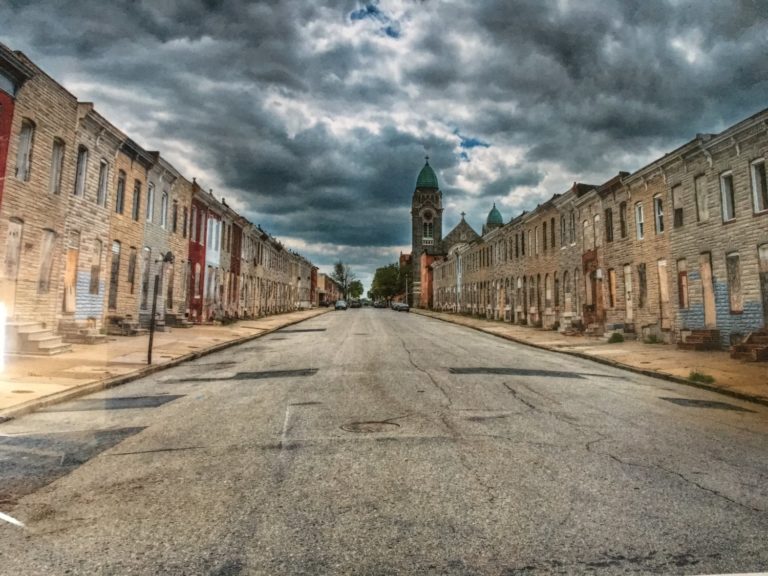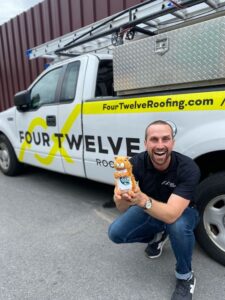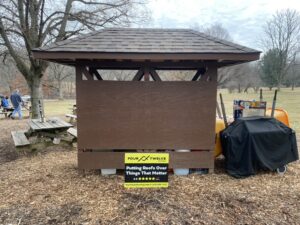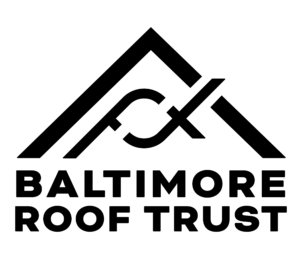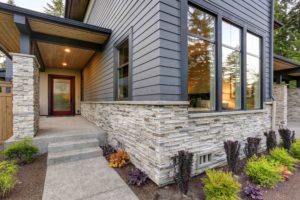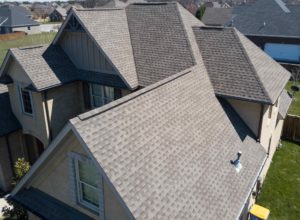[vc_row][vc_column][vc_column_text]
Four Twelve Roofing is a product of the current climate in Baltimore City.
As many post-industrial cities across America have fallen into decay, they have also experienced a resurgence. The economy has improved and cultural awakenings have blossomed in urban areas. Nowhere is this more apparent than in Baltimore.
The birth of Four Twelve fell out of a public policy program called the Vacants to Value (or V2V) program. The V2V program is an effort by local government to catalogue vacant homes and make them available to homebuyers and investors. Following the financial crisis of 2008, Baltimore City – like many US cities – was burdened with an oversupply of housing. Whenever we have out-of-town visitors come to Baltimore, they are always shocked when driving around the city – there are blocks upon blocks of homes that lay unoccupied, overgrown and neglected.
[/vc_column_text][/vc_column][/vc_row][vc_row][vc_column][vc_column_text]
Baltimore has a rich history of building homes – specifically brick rowhomes. These homes date back to as early as 1799, with around 270,000 homes constructed before 1949. If you’ve lived in Baltimore, you’ll note the different types of rowhomes. Often, whole blocks will be built in the same style, but as you travel around the city, styles will vary tremendously. The article below does a fantastic job of highlighting the differences.
http://thebaltimorechop.com/2014/05/02/a-reference-guide-to-baltimore-rowhouse-types/
Developers would buy anywhere from a few homes to 20 blocks of land. They would then build neighborhoods for working class, wealthy elite or mixed income housing so that servants could live close by to the families they worked for. Depending on the developer building these homes, styles varied. Small details in the way these homes were designed, would become calling cards of certain homebuilders, their style influencing the aesthetics of the neighborhoods they constructed.
All of us being residents of Baltimore City, the team at 412 can attest to the sense of community one feels when living on a rowhome block. Living in close proximity to your neighbors allows for deeper relationships with people you may not traditionally choose to be a part of your life. To us, these connections are important. Over time we have come to regard the way these blocks were originally planned and we want to build on this vision through our work.
The Vacants to Value program is a special opportunity. It allows citizens to play a part in repairing their communities. The program allows homebuyers to buy homes for cheap. Vacant homes purchased through the City currently sell for $5,000. This also shows a commitment by City government to rebuild Baltimore, rather than scrapping all that this city has accomplished over the past couple hundred years.
Given our interest in homebuilding and our love of Baltimore, we fell in naturally with this program, and the journey to date has been extraordinary.
Some of our readers may live outside of Baltimore, and be hearing these things for the first time. Others may have knowledge of the V2V program, but have never been on a documented voyage of what it takes to bring a vacant home to life. We wanted to share with you our experience with the program, so you can re-live the efforts we put into our first house – 412 E. Lanvale – the vacant for which our company is named after.
412 E. LANVALE – A HISTORY OF THE PROPERTY
After purchasing 412 Lanvale and beginning work on the property, word got out amongst our friends. People were really excited about what we were doing. One friend reached out to us about doing a profile on the house. He was studying at a local university and wanted to dedicate his Thesis to a historical profile on 412 Lanvale. It’s always awesome when you have brilliant friends who want to collaborate and we were thrilled to hear about his interest.
Through the course of his research, we found out some interesting things about the property.
Through deed records, we know the home was built in 1917. The original owner of the house, purchased two homes side by side, 412 Lanvale and 414 Lanvale. Upon exploration of the purchase agreement, it looks like the homes were paid for, not with money, but with wood. The purchaser of the home worked at a lumber company and traded lumber with the developer in exchange for these homes.
Between the years of 1917 and 2013 (the year we came into possession of this home), the house changed hands many times – serving as a primary residence as well as a rental property. First, there was a prominent investor, who was written up by the police after an intern at his company wrote a series of bad checks and he took the blame in the media. In the 1950s, we found our house listed in a local newspaper, “Bedroom for rent. $15 per month.” This one made us particularly sad, because we have never experienced the good old days of $15 rent. Eventually the house found its way into the hands of Baltimore City, and subsequently it was rented out as a low income residence. During this period, apparently the home caught a reputation as a party house. Anyone who wanted to “tune in and drop out”, knew that this was a welcome place – hence the paraphernalia we found strewn across the floors when we moved in.
Then the property fell to us, and we had one more special encounter with history. During the writing of this piece, our friend identified a relative of the man who originally purchased this property. We got to spend an afternoon with his great-grandson, taking him inside the finished home and showing him what we had done with the place.
This was the beginning of Four Twelve’s remodeling in Baltimore.
[/vc_column_text][vc_media_grid grid_id=”vc_gid:1527700453312-74c7f476-c539-0″ include=”2410,2409,2408,2407,2406,2405″][vc_column_text]
ONCE UPON A TIME…WHEN WE PURCHASED OUR FIRST VACANT
Here is a photo of 412 E. Lanvale from the day we bought it.
Pretty cool, right.. What a way to transform mental associations connected with seeing a home all boarded up. These artworks came to life through a program put on by the Greenmount West neighborhood association. The neighborhood association commissioned artists to come paint boarded-up houses with colorful designs to beautify the block. We still have one of these painted boards sitting in our offices today – a reminder of the continued efforts our neighbors make to improve the place we live.
But the photo to the left shows you what it looked like, once you uncovered the painted plywood boards.
Like a haunted house, right?
Well, the inside could have easily fit this description.
Below is a series of photos showcasing the decay the home has experienced over years of sitting vacant.
Exposed to the elements, all the kitchen cabinetry had begun to shed its veneers, and as the drywall got logged with water it began to fall off the walls. As the drywall began to crumble, old fiberglass insulation littered the rooms. Breathing in this air is how people fall ill in the construction trades. If you’ve ever had insulation on your skin, you can surely sympathize. And also, we found a big, little stash lying on the bathroom floor. Anyone who has watched HBO’s show The Wire, knows that glass vials with red tops usually contain crack-cocaine or heroine.
Oftentimes the fate of these homes takes on the following story arc: a homeowner cannot afford the maintenance or the mortgage payments, they will be foreclosed upon, the city will claim the home, and the home will fall into the hands of trespassers.
In the case of 412 Lanvale, the home was claimed by the City in 2011, so it had gone fully 2 years without any residents. And who knows how long it sat, unoccupied, before the City claimed it in 2011.
So…what is one to do when they just purchased a place that looks like this?
Demo Party!
This being our first project, we decided to usher in the building process with a ceremony (of sorts). We invited all of our friends together on a Sunday, everyone put on a respirator and a pair of gloves, and we got to work on dismantling the inside of the house.
To the right is an image of one of our buddies lending a helping hand at the demo party.
SO…WHAT NEXT?
When you see a house in this poor of shape, you may wonder – can you save anything? In this particular project, the home was in very poor shape. The only thing of significance that we left behind were the four brick walls that made up the structure. In terms of the other materials – we literally replaced every piece of wood in the house, and ended up hauling away 10 dumpster-loads of debris.
Stay tuned for Part 2 of this article, “Rehabbing a Vacant: The Story of Our First Home.”
[/vc_column_text][/vc_column][/vc_row][vc_row][vc_column][/vc_column][/vc_row]

